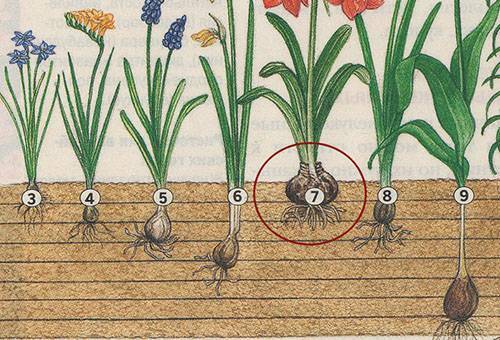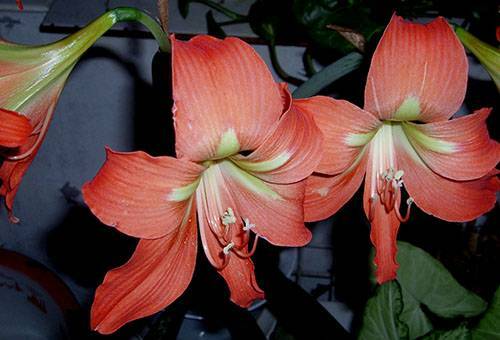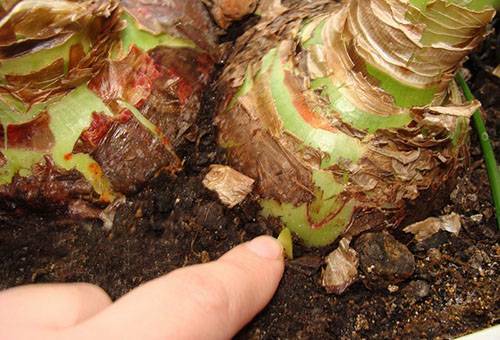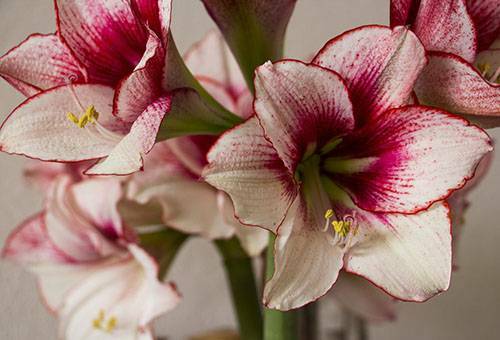Contents:
- How to plant hippeastrum?
- Rules for watering and fertilizing
- Transplantation and reproduction
- Problems in growing
Some growers may have a question: why does not flower gippeastrum? Perhaps it's all about wrong care. After all, under favorable conditions, flowers on this onion plant appear twice a year. It comes from South America. His leaves are dark green, and flowers are especially appreciated for variety and beauty. They can be both snow-white, and purple, and other shades. Inflorescences large, on the peduncle they can be up to five pieces.

How to plant hippeastrum?
Some nuances that are useful to know when growing hippeastrum, at home:
- plants, whose flowers are painted in light shades, yield some quality seeds;
- if there is a possibility, it is necessary to move the gippeastrum to the garden for the summer period;
- flowering moments can be controlled;
- for planting are suitable only bulbs of large size, they have accumulated a sufficient supply of nutrients.
At home, this plant is grown in pots that are long and narrow in shape. The distance from the bulb to the edge should not exceed two centimeters, while the depth should be sufficient for a developed root system.

The bulb is immersed in the soil for two thirds. It is not necessary to fill a pot, it is better to wait until the earth settles. Only after that, fill the right amount. The soil must be prepared beforehand: mix two parts of turf ground and one peat, humus, sand. You can use a special ground mixture designed for bulbous. It is better to sterilize the soil. It is important not to forget about the drainage layer. The earth should contain a sufficient level of nutrients.
At home, caring for the hippeastrum should include the correct site selection for the plant. It loves light, so it is optimal to grow it near a window located on the sunny side. Well withstand direct sunlight. He also has a period of rest during which all the leaves fall off. At this time it is better to move the pot in a dark cool place. The temperature, which is needed for growing hippeastrum, is up to 25 degrees in summer. In the cold season, it can be lower.

Rules for watering and fertilizing
In order for the plant to grow well and bloom at home, watering it should also be approached wisely. At the beginning of winter, to awaken the hippeastrum from rest, the pot with the bulb is taken out and put in a well-lit place. Before the beginning of the growing season, that is, until a flower arrow is formed, one should not water. Otherwise, there is a risk of ruining the bulb by excessive moisturizing. When the flower stem starts to grow, the plant should receive enough water in sufficient quantity, gradually it will increase. It is important not to overdo it: if you start to water excessively, then the leaves will start to grow, and the flowers will not appear. Do it better through a tray or on the edge of the pot.
After the hippeastrum has blossomed, the leaves begin to grow, the future peduncles are laid. Therefore, the plant should receive enough moisture. By the end of summer, when the rest period begins, watering should be stopped. Only if the room is warm, gradually pour on the edge of the pot.
Council
If it is necessary to accelerate the distillation, then large bulbs should be lowered into a warm( about 40 degrees) water for two hours. Then plant, flowering will come in three weeks.
Hippeastrum at home needs and feeding. It should be carried out when the flower stem grows to 15 cm. If the flower was recently transplanted, then it can be done later: in the soil, in this case, there are enough useful elements. To choose is better phosphoric-potash fertilizers, but not nitrogenous. The concentration of minerals should not be too great not to burn the roots.

Transplantation and reproduction of
Gippeastrum can be transplanted approximately one month after the flowering has ended, or before the end of the rest period. Do this enough every two to three years. But it is desirable to replace the top part of the earth every year in order to provide a sufficient number of substances necessary for growth. Transplant is a way of transshipment, which will keep the roots intact.
Propagation of this plant at home is carried out using seeds or dividing the bulb. If the seed method is chosen, then the flowers must be pollinated. The flower-bud should not be cut in this case, the seed box will mature on it. The resulting seeds must be sown immediately after harvesting. If you postpone this matter, they will go much worse. The depth should be about a centimeter, the shoots will spike in a couple of weeks. Put them to a bright place. From time to time they need to be fertilized with strongly diluted mineral fertilizers.
It is best to use this method if you plant the hippeastrum in the open ground in summer. The bees will be able to pollinate the plant, and the bulb will receive a lot of nutrients from the earth. So the plant will not weaken, and the ripening of the seeds will not affect the subsequent flowering.
At home, it is easier to propagate hippeastrums with daughter bulbs. If they reached 2 cm, then during the transplant they can be deposited, previously separated with a sharp sterile instrument. In two, at most three years, the plant will begin to bloom. Until that time, you should not clean the leaves even during rest.
However, sometimes there is such a situation that on the bulb do not appear "babes".Then proceed as follows: cut it into two or four parts. They sprinkle with crushed charcoal and dry for a couple of days. After that, they are planted in the earth mixture, not deepening. Each share must have a part of the bottom.
You can also cut the bulb not completely, but simply cut it. They should also be treated with crushed coal, then put the onion on prepared soil. You need to water only through the pallet. After a while there will be small bulbs. Use this method is best in November, when there is a large supply of nutrients.

Problems in the cultivation of
Even with a seemingly right care at home, the question of why hippeastrum does not bloom may become relevant. This happens for the following reasons:
- insufficient soil nutrient;
- waterlogging, which leads to rotting of the bulb;
- pest infestation.
You can also run into diseases. The most common and dangerous is a red burn, or staganosporosis. Its signs are red stains and dots on the bulb. If such marks are found, then they should be immediately cut out, and the bulb should be treated with an anti-infection agent, for example, "Fitosporin".In other diseases, treatment is carried out in the same way. It can be powdery mildew, which is characterized by white bloom, and red rot. If pests are wound up, they get rid of them with the help of insecticides.
Caring for the hippeastrum will require some effort. It is important to observe the conditions of detention, watering and feeding on time, and also to send them to rest for a while. But as a result, you can get beautiful flowers that will serve as a real decoration for any home.
Read article on current, how to care for aloe
